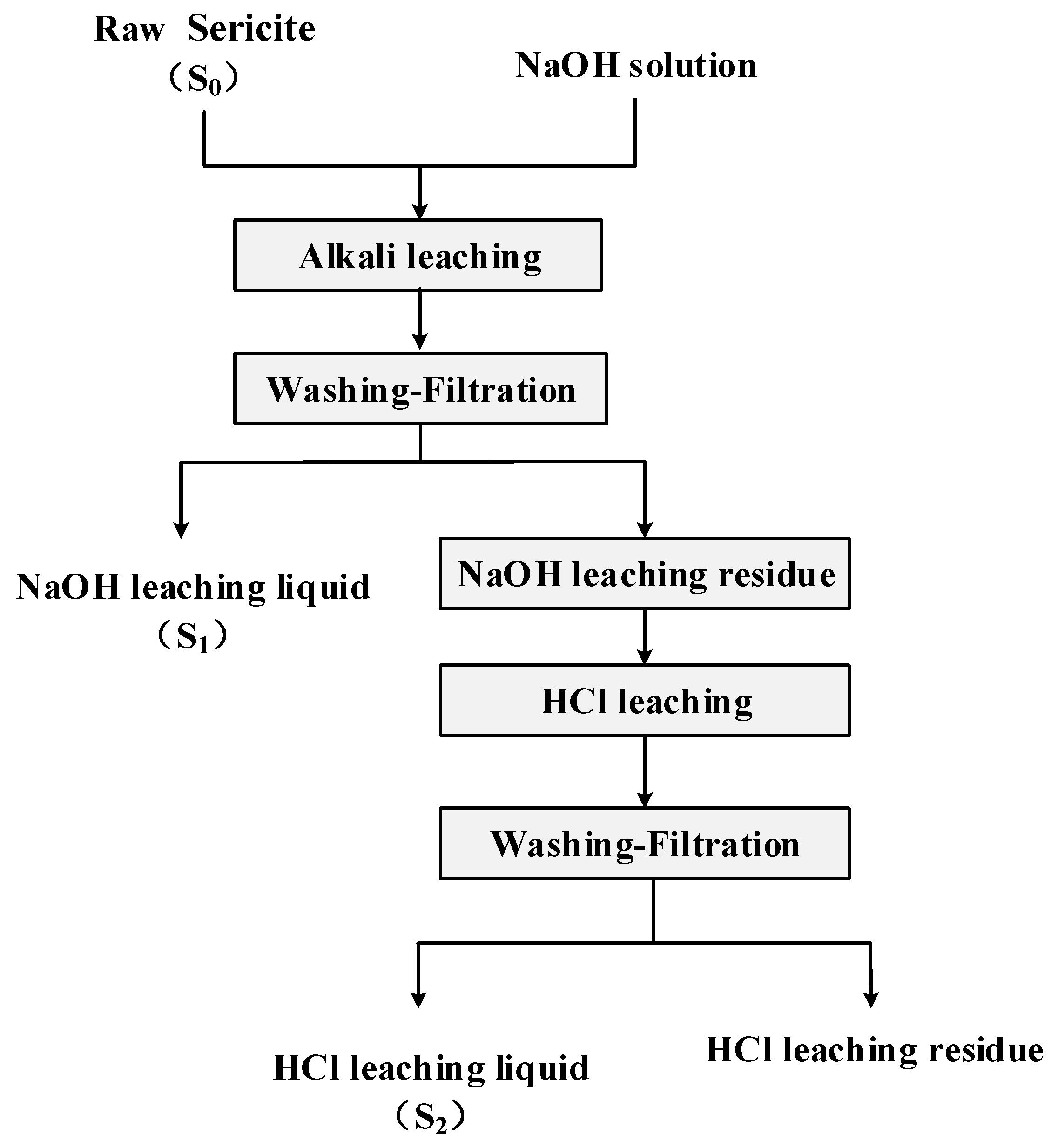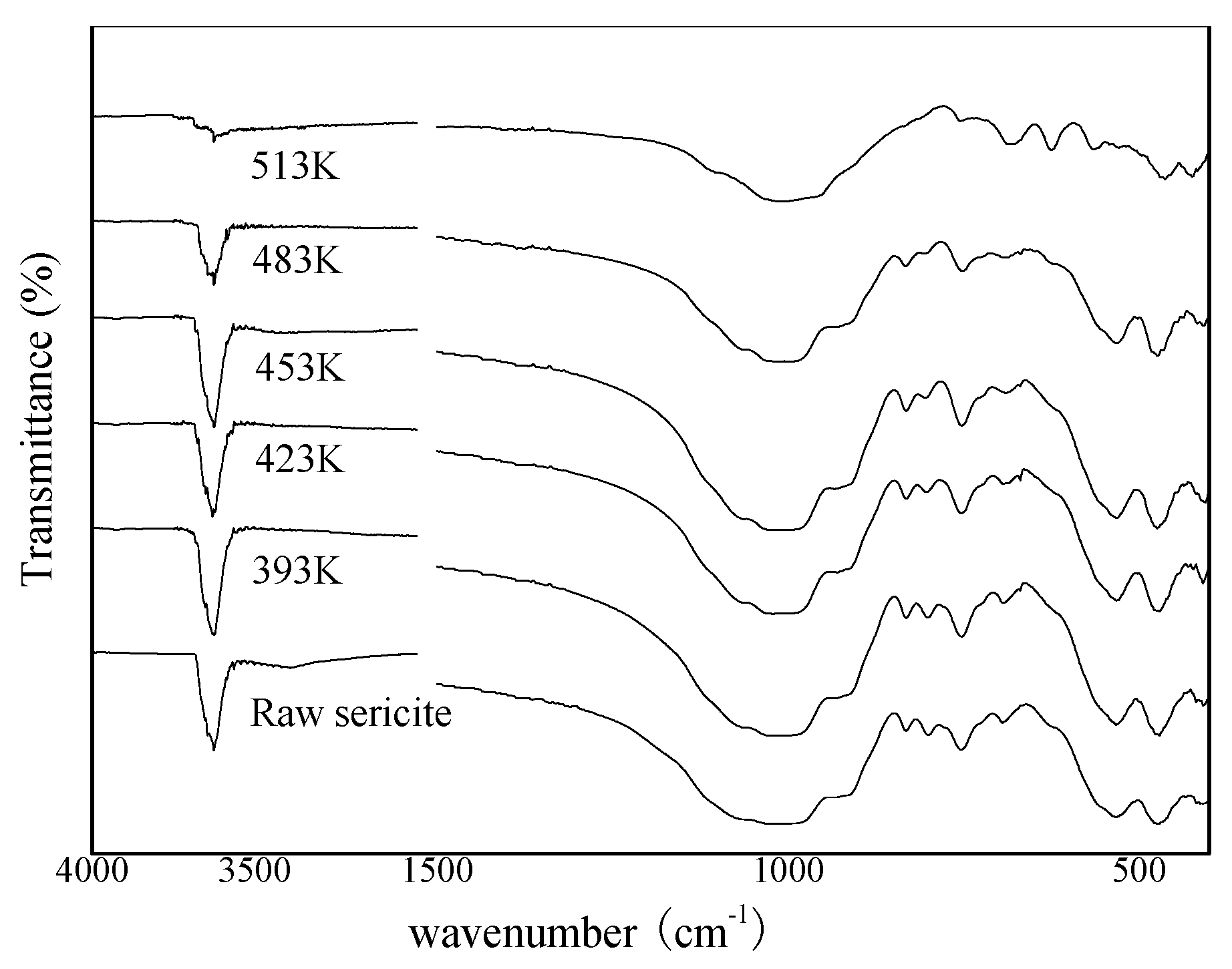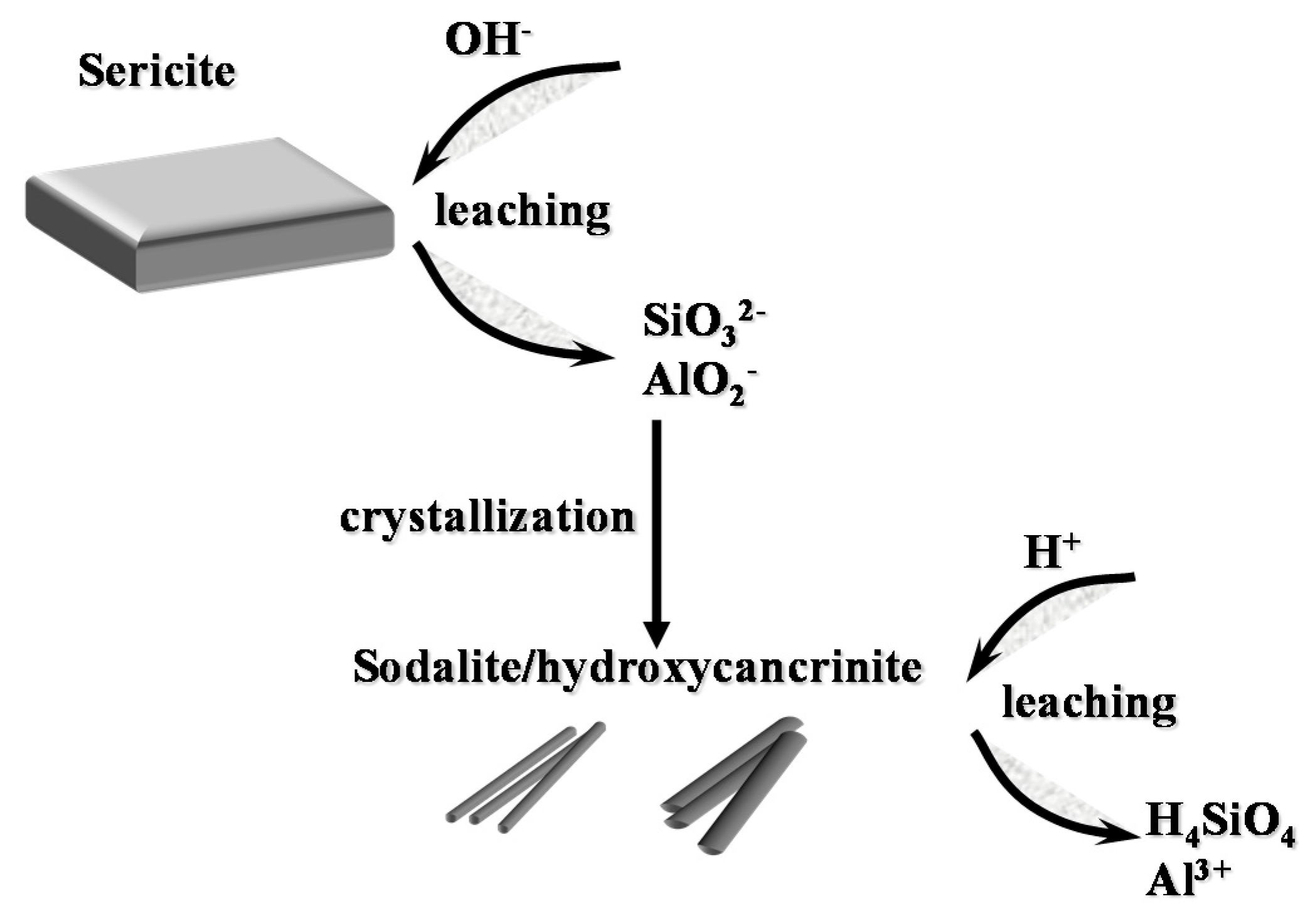Insights into Alkali-Acid Leaching of Sericite: Dissolution Behavior and Mechanism
Abstract
:1. Introduction
2. Materials and Methods
2.1. Materials and Reagents
2.2. Characterization
2.3. Procedure
3. Results and Discussion
3.1. Leaching Tests
3.2. Analysis of Alkali-Leached Residue
3.2.1. XRD Analysis of Alkali-Leached Residue
3.2.2. FTIR Analysis of Alkali-Leached Residue
3.2.3. SEM-EDS Analysis of Alkali-Leached Residue
3.3. Analysis of Acid-Leached Residue
4. Conclusions
Supplementary Materials
Acknowledgments
Author Contributions
Conflicts of Interest
References
- Wang, X.; Gai, G.S.; Yang, Y.F.; Shen, W.C. Preparation of natural microcrystalline graphite with high sphericity and narrow size distribution. Powder Technol. 2008, 181, 51–56. [Google Scholar] [CrossRef]
- Song, S.H.; Jeong, H.K.; Kang, Y.G.; Cho, C.T. Physical and thermal properties of acid-graphite/styrene-butadiene-rubber nanocomposites. Korean J. Chem. Eng. 2010, 27, 1296–1300. [Google Scholar] [CrossRef]
- Vilar, E.O.; Cavalcanti, E.B.; Carvalho, H.R.; Sousa, F.B. Cr(VI) electrochemical reduction using RVG 4OOO graphite felt as the electrode. Braz. J. Chem. Eng. 2003, 20, 291–303. [Google Scholar] [CrossRef]
- Li, H.; Feng, Q.; Ou, L.; Long, S.; Cui, M.; Weng, X. Study on washability of microcrystal graphite using float-sink tests. Int. J. Min. Sci. Technol. 2013, 23, 855–861. [Google Scholar] [CrossRef]
- Wang, H.; Feng, Q.; Liu, K. The dissolution behavior and mechanism of kaolinite in alkali-acid leaching process. Appl. Clay Sci. 2016, 132–133, 273–280. [Google Scholar] [CrossRef]
- Chelgani, S.C.; Rudolph, M.; Kratzsch, R.; Sandmann, D.; Gutzmer, J. A review of graphite beneficiation techniques. Min. Proc. Ext. Met. Rev. 2016, 37, 58–68. [Google Scholar] [CrossRef]
- Shih, Y.J.; Shen, Y.H. Swelling of sericite by LiNO3-hydrothermal treatment. Appl. Clay Sci. 2009, 43, 282–288. [Google Scholar] [CrossRef]
- Tiwari, D.; Lalhmunsiama; Choi, S.I.; Lee, S.M. Activated sericite: An efficient and effective natural clay material for attenuation of cesium from aquatic environment. Pedosphere 2014, 24, 731–742. [Google Scholar] [CrossRef]
- Lee, S.M.; Tiwari, D. Organo and inorgano–organo-modified clays in the remediation of aqueous solutions: An overview. Appl. Clay Sci. 2012, 59–60, 84–102. [Google Scholar] [CrossRef]
- Li, Y.; Steefel, C.I. Kaolinite dissolution and precipitation kinetics at 22 °C and pH 4. Geochim. Cosmochim. Acta 2008, 72, 99–116. [Google Scholar]
- Knauss, K.G.; Wolery, T.J. Muscovite dissolution kinetics as a function of pH and time at 70 °C. Geochim. Cosmochim. Acta 1989, 53, 1493–1501. [Google Scholar] [CrossRef]
- Kalinowski, B.E.; Schweda, P. Kinetics of muscovite, phlogopite, and biotite dissolution and alteration at pH 1–4, room temperature. Geochim. Cosmochim. Acta 1996, 60, 367–385. [Google Scholar] [CrossRef]
- Cama, J.; Ganor, J. Dissolution Kinetics of Clay Minerals; Elsevier Ltd.: Amsterdam, The Netherlands, 2015; Chapter 4; Volume 8–9, pp. 1–6. [Google Scholar]
- Oelkers, E.H.; Schott, J.; Gauthier, J.M.; Herrero-Roncal, T. An experimental study of the dissolution mechanism and rates of muscovite. Geochim. Cosmochim. Acta 2008, 72, 4948–4961. [Google Scholar] [CrossRef]
- Yu, X.; Chen, J.; Ma, X.; Yang, D. Impurity engineering of Czochralski silicon. Mater. Sci. Eng. R Rep. 2013, 74, 1–33. [Google Scholar] [CrossRef]
- Lenchuk, O.; Rohrer, J.; Albe, K. Solubility of zirconium and silicon in molybdenum studied by first-principles calculations. Scripta Mater. 2015, 97, 1–4. [Google Scholar] [CrossRef]
- Hairi, S.N.M.; Jameson, G.N.L.; Rogers, J.J.; MacKenzie, K.J.D. Synthesis and properties of inorganic polymers (geopolymers) derived from Bayer process residue (red mud) and bauxite. J. Mater. Sci. 2015, 50, 7713–7724. [Google Scholar] [CrossRef]
- Okudan, M.D.; Akcil, A.; Tuncuk, A.; Deveci, H. Recovery of gallium and aluminum from electrofilter dust of alumina calcination plant in bayer process. Sep. Sci. Technol. 2015, 50, 2596–2605. [Google Scholar] [CrossRef]
- Liu, Z.; Li, W.; Ma, W.; Yin, Z.; Wu, G. Conversion of sulfur by wet oxidation in the bayer process. Metall. Mater. Trans. B 2015, 46, 1702–1708. [Google Scholar] [CrossRef]
- Gladyshev, S.V.; Akcil, A.; Abdulvaliyev, R.A.; Tastanov, E.A.; Beisembekova, K.O.; Temirova, S.S.; Deveci, H. Recovery of vanadium and gallium from solid waste by-products of Bayer process. Miner. Eng. 2015, 74, 91–98. [Google Scholar] [CrossRef]
- Crundwell, F.K. The dissolution and leaching of minerals: Mechanisms, myths and misunderstandings. Hydrometallurgy 2013, 139, 132–148. [Google Scholar] [CrossRef]
- Crundwell, F.K. The mechanism of dissolution of minerals in acidic and alkaline solutions: Part II Application of a new theory to silicates, aluminosilicates and quartz. Hydrometallurgy 2014, 149, 265–275. [Google Scholar] [CrossRef]
- Khajavi, S.; Kapteijn, F.; Jansen, J.C. Synthesis of thin defect-free hydroxy sodalite membranes: New candidate for activated water permeation. J. Membr. Sci. 2007, 299, 63–72. [Google Scholar] [CrossRef]
- Smith, P. The processing of high silica bauxites—Review of existing and potential processes. Hydrometallurgy 2009, 98, 162–176. [Google Scholar] [CrossRef]
- Samal, S.; Ray, A.K.; Bandopadhyay, A. Proposal for resources, utilization and processes of red mud in India—A review. Int. J. Miner. Process. 2013, 118, 43–55. [Google Scholar] [CrossRef]
- Liu, Y.; Naidu, R. Hidden values in bauxite residue (red mud): Recovery of metals. Waste Manag. 2014, 34, 2662–2673. [Google Scholar] [CrossRef] [PubMed]
- Barnes, M.C.; Addai-Mensah, J.; Gerson, A.R. The kinetics of desilication of synthetic spent Bayer liquor seeded with cancrinite and cancrinite/sodalite mixed-phase crystals. J. Cryst. Growth 1999, 200, 251–264. [Google Scholar] [CrossRef]
- Pan, F.; Lu, X.; Wang, Y.; Chen, S.; Wang, T.; Yan, Y. Organic template-free synthesis of ZSM-5 zeolite from coal-series kaolinite. Mater. Lett. 2014, 115, 5–8. [Google Scholar] [CrossRef]
- Wang, H.; Feng, Q.; Liu, K.; Li, Z.; Tang, X. Highly efficient fluoride adsorption from aqueous solution by nepheline prepared from kaolinite through alkali-hydrothermal process. J. Environ. Manag. 2017, 196, 72–79. [Google Scholar] [CrossRef] [PubMed]
- Mezni, M.; Hamzaoui, A.; Hamdi, N.; Srasra, E. Synthesis of zeolites from the low-grade Tunisian natural illite by two different methods. Appl. Clay Sci. 2011, 52, 209–218. [Google Scholar] [CrossRef]
- Novembre, D.; Sabatino, B.D.; Gimeno, D. Synthesis of Na-A zeolite from 10 Å halloysite and a new crystallization kinetic model for the transformation of Na-A into HS zeolite. Clays Clay Miner. 2005, 53, 28–36. [Google Scholar] [CrossRef]
- Rios, C.A.; Williams, C.D.; Fullen, M.A. Nucleation and growth history of zeolite LTA synthesized from kaolinite by two different methods. Appl. Clay Sci. 2009, 42, 446–454. [Google Scholar] [CrossRef]
- Johnson, C.D.; Mallon, A.J.; Worrall, F. Adhered zeolite preparation on and within a muscovite mica by hydrothermal growth. Clays Clay Miner. 2006, 54, 678–688. [Google Scholar] [CrossRef]
- Tang, X.; Feng, Q.; Liu, K.; Li, Z.; Wang, H. Fabrication of magnetic Fe3O4/silica nanofiber composites with enhanced Fenton-like catalytic performance for Rhodamine B degradation. J. Mater. Sci. 2018, 53, 369–384. [Google Scholar] [CrossRef]
- Tang, X.; Feng, Q.; Liu, K.; Luo, X.; Huang, J.; Li, Z. A simple and innovative route to remarkably enhance the photocatalytic performance of TiO2: Using micro-meso porous silica nanofibers as carrier to support highly-dispersed TiO2 nanoparticles. Micropor. Mesopor. Mater. 2018, 258, 251–261. [Google Scholar] [CrossRef]
- Tiwari, D.; Lee, S.M. Novel hybrid materials in the remediation of ground waters contaminated with As(III) and As(V). Chem. Eng. J. 2012, 204–206, 23–31. [Google Scholar] [CrossRef]
- Kim, J.O.; Lee, S.M.; Jeon, C. Adsorption characteristics of sericite for cesium ions from an aqueous solution. Chem. Eng. Res. Des. 2014, 92, 368–374. [Google Scholar] [CrossRef]
- Kwon, T.N.; Jeon, C. Adsorption characteristics of sericite for nickel ions from industrial waste water. J. Ind. Eng. Chem. 2013, 19, 68–72. [Google Scholar] [CrossRef]
- Astorino, E.; Peri, J.B.; Willey, R.J.; Busca, G. Spectroscopic characterization of silicalite-1 and titanium silicalite-1. J. Catal. 1995, 157, 482–500. [Google Scholar] [CrossRef]
- Król, M.; Minkiewicz, J.; Mozgawa, W. IR spectroscopy studies of zeolites in geopolymeric materials derived from kaolinite. J. Mol. Struct. 2016, 1126, 200–206. [Google Scholar] [CrossRef]
- Phung, T.K.; Carnasciali, M.M.; Finocchio, E.; Busca, G. Catalytic conversion of ethyl acetate over faujasite zeolites. Appl. Catal. A Gen. 2014, 470, 72–80. [Google Scholar] [CrossRef]
- Tang, X.; Feng, Q.; Liu, K.; Tan, Y. Synthesis and characterization of a novel nanofibrous TiO2/SiO2 composite with enhanced photocatalytic activity. Mater. Lett. 2016, 183, 175–178. [Google Scholar] [CrossRef]
- Oh, J.E.; Clark, S.M.; Monteiro, P.J.M. Determination of the bulk modulus of hydroxycancrinite, a possible zeolitic precursor in geopolymers, by high-pressure synchrotron X-ray diffraction. Cem. Concr. Compos. 2011, 33, 1014–1019. [Google Scholar] [CrossRef]
- Kuwahara, Y. In situ observations of muscovite dissolution under alkaline conditions at 25–50 °C by AFM with an air/fluid heater system. Am. Mineral. 2008, 93, 1028–1033. [Google Scholar] [CrossRef]
- Liang, W.; Couperthwaite, S.J.; Kaur, G.; Yan, C.; Johnstone, D.W.; Millar, G.J. Effect of strong acids on red mud structural and fluoride adsorption properties. J. Colloid Interface Sci. 2014, 423, 158–165. [Google Scholar] [CrossRef] [PubMed]










| Component | Al2O3 | SiO2 | Fe2O3 | TiO2 | CaO | MgO | Na2O | K2O | P2O5 | Loss on Ignition |
|---|---|---|---|---|---|---|---|---|---|---|
| Content | 28.99 | 50.95 | 2.91 | 0.44 | 0.16 | 0.79 | 0.18 | 7.94 | 0.05 | 7.59 |
© 2017 by the authors. Licensee MDPI, Basel, Switzerland. This article is an open access article distributed under the terms and conditions of the Creative Commons Attribution (CC BY) license (http://creativecommons.org/licenses/by/4.0/).
Share and Cite
Wang, H.; Feng, Q.; Tang, X.; Zuo, K.; Liu, K. Insights into Alkali-Acid Leaching of Sericite: Dissolution Behavior and Mechanism. Minerals 2017, 7, 196. https://doi.org/10.3390/min7100196
Wang H, Feng Q, Tang X, Zuo K, Liu K. Insights into Alkali-Acid Leaching of Sericite: Dissolution Behavior and Mechanism. Minerals. 2017; 7(10):196. https://doi.org/10.3390/min7100196
Chicago/Turabian StyleWang, Hao, Qiming Feng, Xuekun Tang, Kesheng Zuo, and Kun Liu. 2017. "Insights into Alkali-Acid Leaching of Sericite: Dissolution Behavior and Mechanism" Minerals 7, no. 10: 196. https://doi.org/10.3390/min7100196





